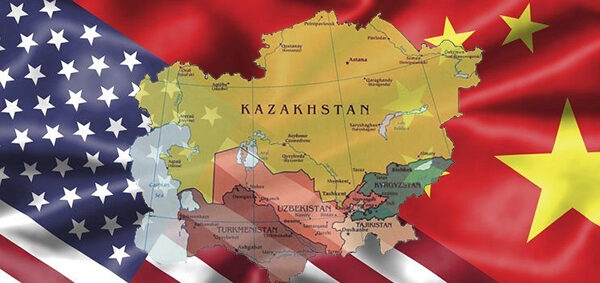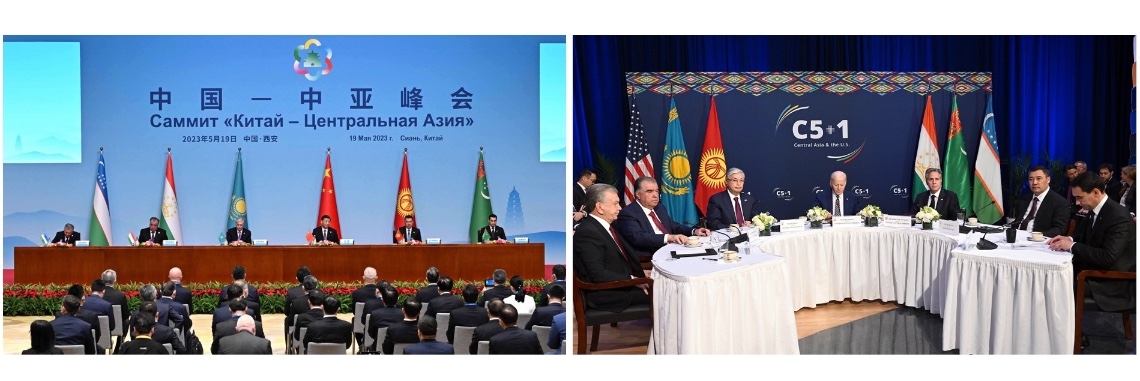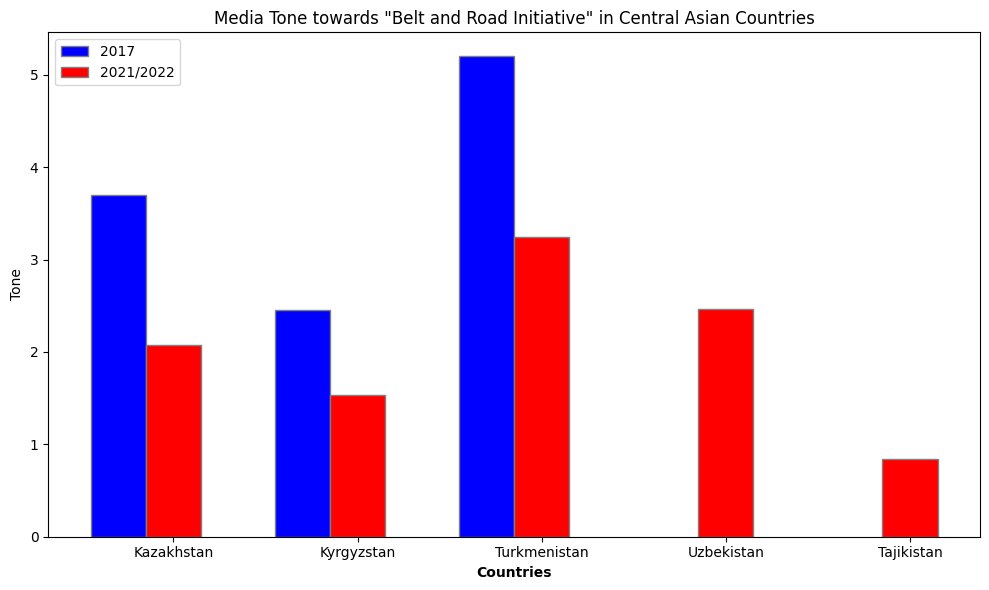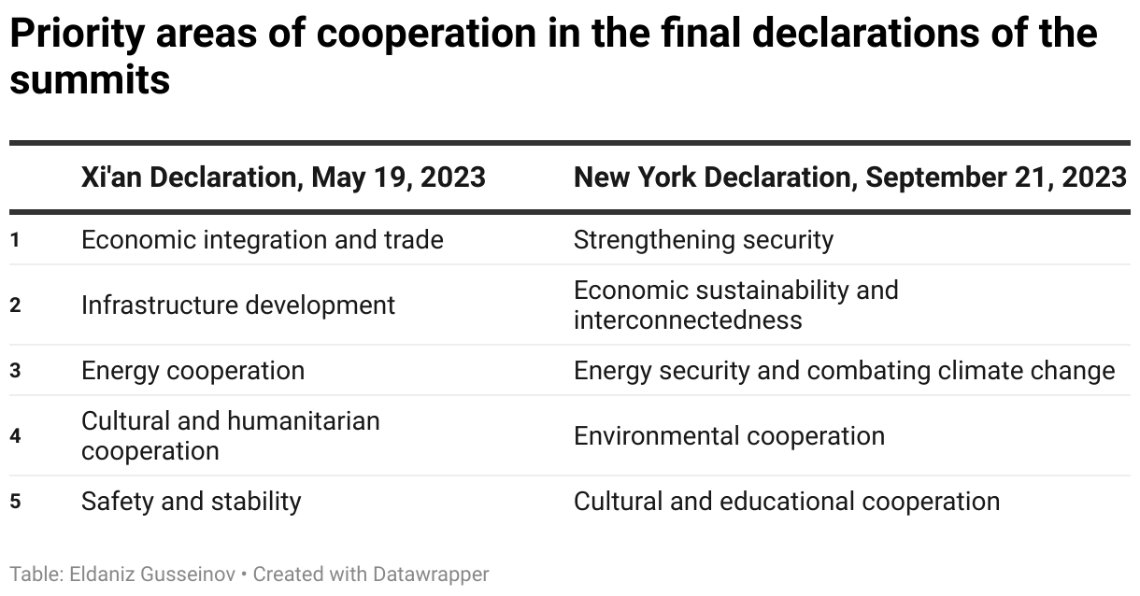


Experts Eldaniz Gusseinov of the Haydar Aliyev Center for Eurasian Studies at Ibn Khaldun University and Abakhon Sultonazarov, Regional Director for Central Asia at IWPR, delve into how the U.S. and China are shaping their strategies in Central Asia. They highlight a distinct shift where Central Asian nations are increasingly allowing external powers to guide their institutional processes. The analysis points to significant consequences for the region’s autonomy and its path towards integration, underscoring the importance of recognizing local interests and fostering internal unity to bolster a collective regional stance.
The U.S. and China have played an important role in institutionalizing cooperation formats in Central Asia. Their participation has helped create structured dialogues and business forums, such as the B5+1 Business Forums and the China-Central Asia Secretariat*. “B5+1” is a joint forum involving the U.S. and five Central Asian countries to promote regional economic integration and increase U.S. private sector trade and investment through annual business forums. The China-Central Asia Secretariat, established in Xi’an, serves as the official cooperation mechanism between China and the Central Asian countries, promoting strategic economic cooperation and supporting high-level summits and ministerial meetings to develop sectors such as trade, energy, high-tech, and green energy.
These initiatives are aimed at strengthening economic ties, enhancing regional integration and addressing collective security challenges.
A rather unique phenomenon in the region is the delegation of the institutionalization process by Central Asian states to external forces, which raises questions about the negative and positive implications of such a process for regional autonomy and integration. While this external involvement has brought some benefits, such as regular meetings and strategic cooperation, it also creates challenges, including the need to take into account the interests of the powers involved and the need to balance them.
Why Central Asian Nations Outsource Institutionalization to External Actors?
Central Asian countries delegate the process of institutionalizing regional cooperation to external actors because of the slow process of intraregional integration. Rustam Burnashev, a professor at the Kazakh-German University, proposes the principle that the countries of the region unite only in response to crisis situations, while in calmer times they prefer to maintain bilateral relations. This means that regional integration is activated only in the presence of an immediate threat or challenge, which leads to its episodic and impermanent nature. External actors can take advantage of the slowdown of integration processes in the region and offer their own formats of cooperation.
The process of institutionalization of cooperation within Central Asia by external actors is conditioned by the following factors:
Analyzing the actions of the U.S. and China in organizing regular meetings with Central Asian leaders at different levels, there is a trend – Central Asian countries delegate the institutionalization of processes in the region. This concerns the possibility of holding regular “B5+1” business forums with U.S. participation, as well as the creation of the China-Central Asia Secretariat. One of the slogans of the “B5+1” business forum points very clearly to the fact of delegation, namely “B5+1 breaks down barriers between Central Asian business and the United States”. The slogan includes the US, but the final communiqué was more about the bottom line benefits for Central Asian countries in joint integration. In this case, the US looked more like a partner in supporting these processes.
In addition, specialized subgroups on agribusiness, transportation and logistics met prior to the forum to prepare recommendations before the major forum. The final document adopted a number of recommendations and proposals that are largely focused not on cooperation between the U.S. and Central Asia, but on promoting cooperation within the region. One example is the mention of “harmonization of legislation in key sectors (such as trade and logistics, agribusiness, e-commerce, tourism, and green and renewable energy)” at the beginning of the final communiqué. And these aspects make this format (business forum) much more distinctive than previously known ones with the participation of other external powers.
Against this background, the question arises: “Why don’t the Central Asian countries initiate similar processes? Many different events took place during the 5th Consultative Meeting of Central Asian Leaders. But the goals and significance of future meetings remain uncertain, as plans for further integration of the region are still unclear.
The final statement following the Consultative Meeting addresses a broader range of political, humanitarian and social issues, including peace, security, humanitarian concerns, and the promotion of cultural and educational exchanges. Because of the huge range of areas of cooperation, it is not always clear how the agreements reached will be implemented. And if it were clear, would there be a need for a separate U.S.-supported business forum to develop recommendations aimed at deepening economic ties in Central Asia?
It is rather difficult to answer this question. At least, the final declarations of the 19th European Union-Central Asia Ministerial Meeting and the final declaration of the Central Asia-Germany Summit welcome the consultative meetings of Central Asian leaders and the signing of the Agreement on Strengthening Land Transport Connectivity in Central Asia. Neither consultative meetings nor this agreement are mentioned in the final communiqués of the Central Asia-U.S. Summit and the B5+1 Business Forum. The Xi’an Declaration of the China-Central Asia Summit also welcomes and praises the consultative meetings of Central Asian leaders. On the other hand, Central Asian experts wonder whether the Council of National Coordinators for the Consultative Meetings of Central Asian Leaders is working. The decision to establish the Council at the fifth meeting on September 14, 2023, but nothing is known about its activities so far.
Delegating Institutionalization Processes in the Region: Impact on Central Asian Integration
It is difficult to unambiguously assess the impact of the launch of the China-US formats (as well as other meetings in the C5+1 format) on the integration processes, as at first glance there are both positive and negative aspects:
Possible Limitations:
In addition, the involvement of external actors in regional integration requires Central Asian countries to take their interests into account. This may complicate the search for common solutions within the framework of cooperation among the five states and lead to changes in the region’s domestic and foreign policy in favor of more powerful partners.
It should be emphasized that within the framework of the interaction of the five Central Asian countries, reaching consensus may be easier than with the involvement of additional participants. This is because the decision-making process is simplified and the number of stakeholders is reduced, which facilitates faster and more effective coordination of actions and common course. This approach can also contribute to a greater focus on regional issues and strengthen the sovereignty of Central Asian countries.
For example, in his remarks after the Central Asia-US summit, US President Joe Biden emphasized strategic autonomy and regional capacity building, especially in terms of security and economic independence. His approach is one of capacity building and connectivity, with a focus on the sustainability of global supply chains and security cooperation.
Meanwhile, Chinese Communist Party Chairman Xi Jinping emphasizes long-term integration and the broader implications of cooperation for “global stability and prosperity” at the Central Asia-China summit. He discusses initiatives such as “One Belt, One Road,” emphasizing large-scale infrastructure projects that link Central Asia more closely to China. In this case, Biden has “Independence” and China has “Connectivity,” indicating a possible conflict of interests between the U.S. and PRC in the region that Central Asian countries should consider.
This should also be taken into account against the backdrop of the growing confrontation of Western countries with the Russian Federation and China. In her recent speech, European Commission President Ursula von der Leyen spoke out on EU-China relations, referring to Chinese President Xi, noting that:
“We can expect a clear course for China to depend less on the world and the world to depend more on China. Or, as President Xi put it bluntly a few years ago: ‘China should tighten the dependence of international production chains on China to form a powerful counter and deterrence capability.‘”
Positive aspects for integration within Central Asia:
For example, since the pandemic, China has increased its involvement in the Central Asian education sector by actively developing cooperative education programs, expanding the network of Confucius Institutes, increasing the number of scholarships and opening new Lu Ban workshops. At the same time, this fits quite neatly into “building a closer China-Central Asia community of shared destiny,” which China’s Deputy Permanent Representative to the UN, Dai Bin, spoke about in the run-up to the Central Asia-China summit.
Central Asia’s engagement with external actors, especially through formats such as the B5+1 with the US and the China-Central Asia Secretariat, demonstrates a unique approach to regional cooperation, which is to delegate the institutionalization process to external actors, in stark contrast to the more inward-looking models seen in regions such as the EU and ASEAN.
Two Powers, Two Approaches: Institutionalization at the Level of Heads of State and Business Communities in Central Asia
The difference in the approach to cooperation with Central Asia between China and the United States is clearly visible in photos from the summits of Central Asian leaders with the leaders of the PRC and the United States in 2023.

Source: mfa.gov.cn и kg.usembassy.gov
It is clear enough that it is important for China to promote cooperation between China and Central Asia at the level of heads of state. The U.S. is gradually shifting its strategy toward greater support for business in the hope that the business community, while strengthening interregional ties, will increasingly demand that Central Asian authorities lower barriers to trade, which may indirectly affect other areas of cooperation. The difference in approaches can be explained by the extent of both U.S. and Chinese relations with Central Asian countries. Here it is important to pay attention to two issues:
You would probably answer “no” to both questions. Therein lies the reason for the choice of strategies for U.S. and PRC engagement with the region. For the U.S., the best platform to promote cooperation is through engagement with civil society and business, as there can be some divergence and misunderstandings at the government level. This includes the exchange of letters between U.S. Secretary of State Anthony Blinken and Kyrgyz President Sadyr Zhaparov regarding the adoption of the Law on Non-Profit Organizations in the Kyrgyz Republic. According to Kyrgyz media, Blinken sent a letter expressing concern about the bill. In his response, Zhaparov said “[that] I regret to note that the content of your letter has signs of interference in the internal affairs of our state.”
Another notable case relates to the Kazakh president’s statement on “Western values”. Speaking at the national kurultai in March this year, President Tokayev said: “we cannot and will not go along with those who, under the influence of Western and other trends, promote values alien to our culture, moreover, going against the dualistic basis of the world. Our children are involved in this destructive propaganda, so the price of the issue is greater than ever – it is the spiritual health of the younger generation“. It is noteworthy that the National Kurultai was held simultaneously with the “B5+1” forum.
On the other hand, it is difficult to find this kind of divergence openly aired in the media. However, China has difficulties in reaching out to the Central Asian population. It is enough to recall the protests against China’s growing economic presence in Kyrgyzstan and Kazakhstan in 2019, and the land rallies in Kazakhstan in 2016. This trend is emphasized by a recent study by Alicia Garcia-Herrero and Robin Shindowski analyzing the tone of media coverage of the One Belt, One Road project in more than 148 countries. The authors found that only the countries of Sub-Saharan Africa and Central Asia in 2022 receive positive coverage of the initiative (see figure below).

According to the study, the media tone in Central Asia is already less positive compared to 2017 figures. The declining attractiveness of the “One Belt, One Road” can be attributed to problems in the course of the initiative’s implementation. For this reason, China may be building a successful track record at the government level. Although it is very important to add that the public attitude, for example, in Kazakhstan, towards China has recently become more positive.
It is also worth noting the difference in the interests of China and the United States in their cooperation with Central Asia. This is evident in the priority areas of cooperation that are enshrined in the final declarations after both summits.

The Xi'an Declaration of the China-Central Asia Summit shows that there is a strong commitment to strengthening economic integration and trade. This is exemplified by initiatives such as "One Belt, One Road" and mechanisms aimed at increasing trade and economic integration. There is also a strong emphasis on infrastructure development, in particular improving regional connectivity through transportation networks such as railways and roads. Energy cooperation is a priority, with projects focusing on both traditional and renewable energy sources, including the Turkmenistan-China gas pipeline. Cultural ties and humanitarian exchanges are emphasized through various initiatives for cooperation in culture, education and heritage. In addition, the declaration emphasizes the importance of maintaining regional security and political stability, stressing a united front against external interference and regional threats such as terrorism and extremism.
The joint statement from the U.S.-Central Asia C5+1 Presidential Summit demonstrates a strong focus on strengthening security, especially in response to the ongoing challenges in Afghanistan and threats of regional terrorism. Economic resilience and connectivity are central, with the U.S. pushing for improved trade relations and supporting infrastructure projects such as the Middle Corridor for trade. The summit also highlights energy security and climate initiatives, advocating for diversification of energy exports and clean energy projects. Environmental management is another critical area, with efforts focused on improving water security and combating the effects of climate change. The declaration also emphasizes the importance of strengthening cultural and educational exchanges aimed at building educational capacity and developing deeper intercultural ties.
China and the U.S. view Central Asia as a strategically important region, but approach cooperation with it differently. China's approach is largely focused on creating economic dependence through infrastructure and trade, anchored by bilateral mechanisms and cultural diplomacy. In contrast, the U.S. prioritizes the creation of a secure and democratic environment, emphasizing human rights and sustainable development as part of its engagement model.
While both powers emphasize the importance of stability and economic growth in Central Asian countries, their methods and directions reflect their broader strategic goals in the region. China's strategic goals in Central Asia include expanding economic influence, securing access to key resources, and strengthening regional connectivity through infrastructure projects such as the One Belt, One Road initiative.
On the other hand, the U.S. seeks to strengthen security, democracy and human rights in the region, as well as to create a counterweight to China's growing influence, especially in areas that are important to the United States. For example, in the extraction of critical resources in Central Asia.